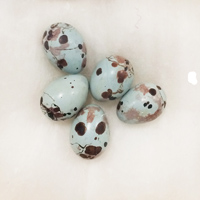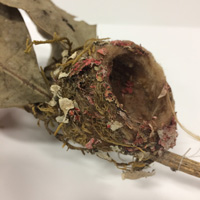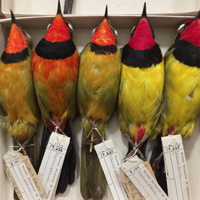MEET THE EGG AND NEST COLLECTIONS OF THE WFVZ – THE HEART OF THE MUSEUM
The WFVZ houses more than four hundred individual collections, totaling more than a million specimens. The Foundation has been a repository for donations of institutional and private collections, resulting in a large number of egg sets and nests in North American museum collections being donated to the WFVZ since the 1970s.
The primary sources for specimens currently are wildlife rehabilitation organizations; car, cat, and window-killed birds; wildlife research agencies and organizations; and the Foundation’s own field research projects. Materials are consistently acquired by the Western Foundation and used by researchers, educators, scientific artists, and other museums. In addition, materials are used in educational tours and presentations for the general public, both at the Foundation and at outside events. All materials are actively maintained to be free of parasites and dust, so that the items can be available for research and education purposes in perpetuity.
If you are interested in donating specimens to the Western Foundation, please contact us for more information before such a donation.
Eggs



The WFVZ houses approximately 250,000 sets of eggs (equal to more than 1,000,000 individual eggs), representing at least 4,000 bird species from around the world, and collected from more than 400 individual and institutional collections. The egg collection of the WFVZ is the largest in the world.
The Western Foundation’s collections have contributed to many scientific fields, such as conservation, ecology, taxonomy, and toxicology. For example, the WFVZ provided photocopies of egg records for more than 500 species, and egg measurements for more than 400 species, covered by Cornell’s “Birds of North America” written and online series. This information and digital pictures of these eggs and nests are now available at Birds of North America.
The Foundation’s egg sets have also figured prominently in studies of eggshell thinning due to contaminants such as DDT and heavy metals. The WFVZ has contributed data to more than 4,000 studies. Thus, the value of the WFVZ’s collections for science, and for the conservation of bird species, continues to be shown.
Staff of the WFVZ provide data on eggs, including measurements and digital images, to researchers. Please see our page about accessing specimens and contact us for more information.
Nests




The Foundation has more than 18,000 specimens from around the world, representing the largest collection of nests in North America and the world.
WFVZ pictures of the nests of North American breeding bird species are available at www.birds.cornell.edu/birdsofna, or researchers can contact us directly for particular digital images.
Study Skins




The WFVZ houses more than 56,000 study skin specimens representing over 100 countries, with the largest numbers of specimens from the United States (>12,900), Mexico (>12,600), Malaysia (>4,400), Costa Rica (>4,000), and Ecuador (>3,800). The skin collection is at least the 16th largest among North American collections.
The primary sources for specimens currently are wildlife rehabilitation organizations; wildlife research agencies; birds killed by cats, window strikes, and car impacts; and the Foundation’s own field research projects. Materials are consistently acquired by the Western Foundation and used by researchers, educators, scientific artists, and other museums. In addition, materials are used in educational tours and presentations for the general public, both at the Foundation and at outside events.
Skin loans are made to qualified researchers. Please see our Specimen Loan page.
The WFVZ houses more than 4,500 “no-data” teaching specimens (skins, wings, egg sets, and nests) that we loan temporarily to local educators for use in the classroom. Our live-mounts of birds are used primarily during our public tours and tours for school and civic groups. We also have a “teaching kit” available that includes background information on 5 different avian science topics (for middle and high school students), a checklist of the birds of Ventura County, and nest, egg, and study skin specimens. All teaching material loans are free. Contact us for more information. Check our online Databases here.
Recent WFVZ Publications about the Collections:
Attard MRG, Bowen J, Corado R, Hall LS, Dorey RA, Portugal SJ. 2021. Ecological drivers of eggshell wettability in birds. J. R. Soc. Interface 18: 20210488. https://doi.org/10.1098/rsif.2021.0488
MARINI, M. A, L. S. HALL, J. BATES, F. D. STEINHEIMER, R. MCGOWAN, L. F SILVEIRA, D. A. LIJTMAER, P. L. TUBARO, S. CÓRDOBA-CÓRDOBA, A. GAMAUF, H. F. GREENEY, M. SCHWEIZER, P. KAMMINGA, A. CIBOIS, L. VALLOTTO, D. RUSSELL, S. K. ROBINSON, P. R. SWEET, S. FRAHNERT, R. CORADO, AND N. M. HEMING. 2020. The five million bird eggs in the world’s museum collections are an invaluable and underused resource. Auk Ornithological Advances 137: 1–7 and supplemental material. DOI: 10.1093/auk/ukaa036
PURCELL, R., L. S. HALL, and R. CORADO. 2008. Egg and Nest. Harvard University Press. 224 pp.
